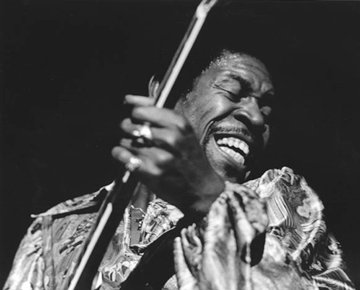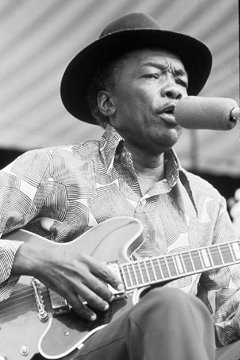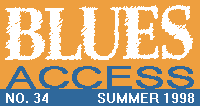
|
|
Ann Arbor Blues Festival (1972-1974) Photographs by Leni Sinclair Text by John Sinclair |
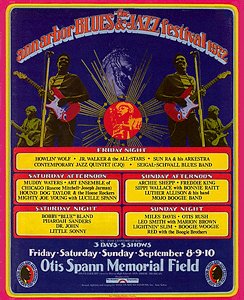 The Ann Arbor Blues & Jazz Festival brought together a wild mixture of modern blues masters and
cutting-edge jazz creators with a riotous crowd of long-haired hippies and music lovers of every
description to brew up an exhilarating blend of African-American music, sunshine and merriment for
three glorious days in September of 1972.
The Ann Arbor Blues & Jazz Festival brought together a wild mixture of modern blues masters and
cutting-edge jazz creators with a riotous crowd of long-haired hippies and music lovers of every
description to brew up an exhilarating blend of African-American music, sunshine and merriment for
three glorious days in September of 1972.
This heady experiment in cross-cultural programming filled Otis Spann Memorial Field with 12,000 ecstatic celebrants for five shows that combined Howlin' Wolf, Jr. Walker & the All-Stars and Sun Ra & His Arkestra; Muddy Waters, the Art Ensemble of Chicago, Koko Taylor and Hound Dog Taylor & the Houserockers; Bobby "Blue" Bland, Pharaoh Sanders, Dr. John and Little Sonny; Freddie King, Archie Shepp, Sippie Wallace, Bonnie Raitt and Luther Allison; Miles Davis, Otis Rush, Lightnin' Slim, Leo Smith & Marion Brown, Robert Lockwood and Johnny Shines.
Problems with city authorities prompted the organizers to move the festival to Windsor, Ontario - across the Detroit River - in 1974. Attendance shrunk, and disaster struck when Canadian border officials turned back thousands of American music lovers bent on attending the Ann Arbor Blues & Jazz Festival in Exile. This brought the series to a shuddering conclusion, but the extraordinary music made at the three fests was preserved on tape and may be heard on a continuing series of CDs. The striking images of the artists captured in performance by photographer Leni Sinclair surely convey the excitement and thrills felt by everyone when they encountered most of them for the first time - some of the greatest musicians of our age.
| |||||
| |||||
The legendary One-String Sam had languished in utter obscurity since his mid-'50s
recording of "l Need $100" was released to an unsuspecting world by
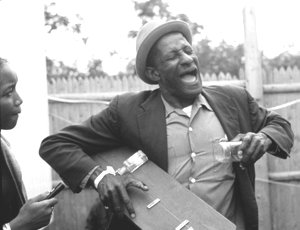 Detroit's miniscule JVB label. Located in an Inkster housing project in 1973, Sam was added
to the Motor City Blues Revue and turned his 15 minutes onstage into a
rousing, crowd-pleasing tour-de-force, fretting his one-string guitar
with a baby-food jar that - stuck up next to the microphone - doubled as
an echo chamber for his wailing vocal plaints.
Detroit's miniscule JVB label. Located in an Inkster housing project in 1973, Sam was added
to the Motor City Blues Revue and turned his 15 minutes onstage into a
rousing, crowd-pleasing tour-de-force, fretting his one-string guitar
with a baby-food jar that - stuck up next to the microphone - doubled as
an echo chamber for his wailing vocal plaints.
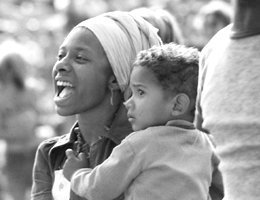
The surprise hit of the festival, One-String Sam remained on-site until the end, entertaining his new fans with a series of impromptu performances backstage and on the festival field itself. | |||||
This page © 1998 by Blues Access, Boulder, CO, USA.
 |
 |

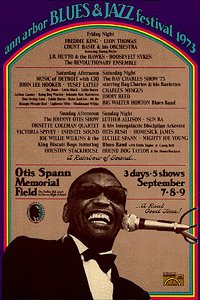 The festival returned in 1973 with an even more ambitious agenda, offering five insane combinations which
presented on-the-same-stage performances by Roosevelt Sykes, Leon Thomas, the Count Basie Orchestra
and Freddie King; Yusef Lateef, John Lee Hooker, CJQ and a Motor City Blues Revue that included
Baby Boy Warren, Washboard Willie, Dr. Ross, Eddie Kirkland, Boogie Woogie Red, Eddie Burns,
Bobo Jenkins and One-String Sam; Ray Charles, Charles Mingus, Big Walter Horton and Jimmy Reed;
the Johnny Otis Show, Ornette Coleman, King Biscuit Boys and Victoria Spivey; and Luther Allison,
Hound Dog Taylor and Sun Ra - three perennial favorites with the Ann Arbor audience.
The festival returned in 1973 with an even more ambitious agenda, offering five insane combinations which
presented on-the-same-stage performances by Roosevelt Sykes, Leon Thomas, the Count Basie Orchestra
and Freddie King; Yusef Lateef, John Lee Hooker, CJQ and a Motor City Blues Revue that included
Baby Boy Warren, Washboard Willie, Dr. Ross, Eddie Kirkland, Boogie Woogie Red, Eddie Burns,
Bobo Jenkins and One-String Sam; Ray Charles, Charles Mingus, Big Walter Horton and Jimmy Reed;
the Johnny Otis Show, Ornette Coleman, King Biscuit Boys and Victoria Spivey; and Luther Allison,
Hound Dog Taylor and Sun Ra - three perennial favorites with the Ann Arbor audience.
